Tom's Hardware Verdict
A speed demon that prioritizes raw performance, the Alienware m17 R4 puts plenty of pop into a sleek but bulky chassis.
Pros
- +
Unrivaled performance
- +
Awesome mechanical keyboard
- +
Attractive design
Cons
- -
Noisy fan
- -
Heavy
Why you can trust Tom's Hardware
At present, RTX 3080 is the fastest laptop graphics card around, but not all RTX 3080-powered laptops are created equal. Many vendors use Nvidia’s Max-Q technology, which prioritizes power efficiency and low fan noise over high performance. Alienware’s m17 R4, however, seeks to pump out every possible frame, deploying a special cooling system and eschewing Max-Q to make its top-of-the-line configuration one of the best gaming laptops. We were able to check the TGP (Total Graphics Power) of the laptop, which was reported as 165W in Nvidia's drivers — in the "150W+" range listed for mobile RTX 3080.
But the Alienware m17 R4 is not just a speed demon. Starting at $2,106 ($3,586 as tested), this laptop has a sleek sci-fi inspired design with plenty of RGB, an optional 360 Hz screen and a snappy (optional) mechanical keyboard, the first with Cherry MX Ultra Low Profile Switches. You just have to live with a heavy chassis and the occasional bout of fan noise.
Editor’s Note: We originally published this review in February, but updated in April to add our experience testing with Alienware's new, optional mechanical keyboard.
Alienware m17 R4 Specifications
| CPU | Core i9-10980HK |
| Graphics | Nvidia GeForce RTX 3080 |
| Memory | 32GB DDR 2933 MHz |
| Storage | 512GB Boot, 2TB (2 x 1TB RAID 0) SSD |
| Display | 17.3-inch, 1920 x 1080 360 Hz |
| Networking | Killer Wi-FI AX1650 (Wi-Fi 6), Killer Ethernet 2.5 Gbps NIC, Bluetooth 5.1 |
| Ports | 3x USB Type-A 3.2, 1x HDMI 2.2, 1x mini DisplayPort 1.4, 1x Thunderbolt 3, 1x microSD card reader |
| Camera | 1280 x 720 |
| Battery | 86 WHr |
| Power Adapter | 330W |
| Dimensions (WxDxH) | 15.74 x 11.56 x 0.87 inches |
| Weight | 6.6 pounds |
| Price (as configured) | $3,586 |
Design of the Alienware m17 R4





The Alienware m17 R4 has the same sci-fi inspired “Legend” design as both its immediate predecessor, the m17 R3, and its sibling, the Alienware m15 R4. Available in "lunar light: white or "dark side of the moon" (black), the m17 R4 looks like a giant starship, rocketing through space. The body (ours was white) has a black rear end that juts out like the jet engine on the back of an imperial cruiser. The number 17 on the lid appears in a sci-fi font that you might find adorning a secret warehouse at Area 51.
There’s a honeycomb pattern for the vents on the back, above the keyboard and on the bottom surface. We can only assume that Alienware aliens live in some kind of hive where they are all doing CUDA core calculations.
And, of course, there’s lots of RGB lights to brighten the mood in outer space. The standard keyboard has four-zone RGB and there are customizable lights on the back edge and in the alien heads on the back of the lid and the power button. However, an optional keyboard upgrade and the optional mechanical keyboard both provide per-key lighting.
The chassis is made from premium materials: a magnesium alloy with matte white or black paint, covered by a clear coat for extra durability. The interior uses Alienware’s cryo-tech cooling technology which has 12-phase graphics voltage regulation, 6-phase CPU voltage regulation and a CPU vapor chamber.
At 6.6 pounds and 15.74 x 11.56 x 0.87 inches, the Alienware m17 R4 is not exactly light or thin, not that would you expect that from a 17-inch laptop with a Core i9 CPU and RTX 3080 graphics. By comparison, the Gigabyte Aorus 17G (5.95 pounds, 15.9 x 10.8 x 1.0 inches) and Razer Blade Pro 17 (6.1 pounds, 15.6 x 10.2 x 0.8 inches) are both significantly lighter, though the Aorus is thicker. The Asus ROG Flow X13, which we’re also comparing to the m17, is much thinner and lighter (2.87 pounds, 11.77 x 8.74 x 0.62 inches), because it’s a 13-inch laptop that gets its RTX 3080 graphics via an external dock.
The Alienware m17 R4 has plenty of room for ports. On the right side, there are two USB 3.2 Type-A ports, along with a micro SD card reader. The left side contains a Killer RJ-45 Ethernet 2.5 Gbps port, a 3.5mm audio jack and another USB Type-A port. The back holds a Thunderbolt 3 port, a mini DisplayPort 1.4, an HDMI 2.1 connection, Alienware’s proprietary graphics amplifier port and the power connector.
Gaming Performance on the Alienware m17 R4




Sporting an Nvidia RTX 3080 GPU and an Intel Core i9-10980HK CPU, our review configuration of the Alienware m17 R4 is as fast of a gaming laptop as you can get right now. Thanks to Alienware’s strong cryo-tech cooling solution and the company’s willingness to include a full version of the RTX 3080, rather than the Max-Q variants in some thinner notebooks.
When I played Cyberpunk 2077 at Ultra RTX settings, the game ranged between 61 and 72 frames per second, depending on how intense the action was at any given time. The frame rate improved to between 85 and 94 fps after I changed to Ultra settings with no RTX. In both cases, the fan noise was really loud by default. Changing the fan profile to quiet improved this somewhat while shaving only a couple of fps off, and only in intense scenes.
The Alienware m17 R4 hit a rate of 120 fps in Grand Theft Auto V at very high settings (1080p), eclipsing the Gigabyte Aorus 17G and its Max-Q-enabled RTX 3080 and Core i7-10870H CPU by 20%. The Asus ROG Flow 13 with its Ryzen 9 5980HS CPU and external RTX 3080 dock, was also a good 13% behind while the RTX 2080 Super-powered Razer Blade Pro 17 brought up the rear.
On the very-demanding Red Dead Redemption at medium settings, the m17 R4 achieved an impressive rate of 79.7 fps, besting the Aorus 17G and ROG Flow X13 by more than 20%. Saddled with last year’s card, the Razer Blade Pro 17 was a full 29 % behind.
Alienware’s behemoth exceeded 100 fps again in Shadow of the Tomb Raider, hitting 103 while the Aorus 17G hovered in the mid 80s. On this test, surprisingly, the Razer Blade Pro 17 came close to matching the m17 R4.
Far Cry New Dawn at Ultra settings also provided a great example of the Alienware m15 R4’s dominance. It hit a full 105 fps where its nearest competitor, the Gigabyte Aorus 17G could only manage 92 fps with the Asus ROG Flow X13 and Razer Blade Pro 17 were both in the 80s.
To see how well the Alienware m17 R4 performs over the long haul, we ran the Metro Exodus benchmark at RTX, the highest settings level, 15 times at 1080p. The laptop was remarkably consistent, averaging 75.6 fps with a high of 76.2 and a low of 75.4. During that time, the average CPU speed was 4.19 GHz with a peak of 5.088 GHz. By comparison, the Gigabyte Aorus 17G, got an average frame rate of just 59.6 fps with an average CPU speed of 3.47 GHz and the Asus ROG Flow X13 managed a slightly-higher 65.2 fps with an average CPU speed of 3.89 GHz.
Productivity Performance of Alienware m17 R4



With its Core i9-10980HK CPU, 32GB of RAM and dual storage drives, which include both a 2TB RAID 0 PCIe SSD (2 x 1TB) and a 512GB SSD, and that RTX 3080, our review configuration of the Alienware m17 R4 can be a powerful work tool.
On Geekbench 5, a synthetic benchmark that measures overall performance, the m17 R4 got a single-core score of 1,318 and a multi-core score of 8,051, which wa slightly ahead of the of the Core i7-10870H-powered Gigabyte Aorus 17G on both counts but behind the Asus ROG Flow X13 and its Ryzen 9 5980HS on single-core performance while creaming the Razer Blade Pro 17, which we tested with a Core i7-10875H.
The storage in our review unit came misconfigured slightly, with a 512GB NVMe PCIe SSD as boot drive and a significantly faster 2TB RAID 0 drive made from two 1TB NVMe PCIe SSDs. Dell sells this hardware, but consumers receive units with the 2TB as boot and the 512GB SSD as a secondary, storage drive.
In our tests, copying about 25GB of files, the 512GB drive managed a mediocre 379.7 MBps, but the 2TB drive hit an impressive 1305.5 MBps, which beats the Aorus 17G (869 MBps), the ROG Flow X13 (779.5 MBps) and the Blade Pro 17 (925.2 MBps).
The Alienware m17 R4 took just 6 minutes and 44 seconds to transcode a 4K video to 1080p in Handbrake. That time is 21% faster than the Aorus 17G, 18% quicker than the Flow X13 and a full 29% ahead of the Blade Pro 17.
Display on Alienware m17 R4
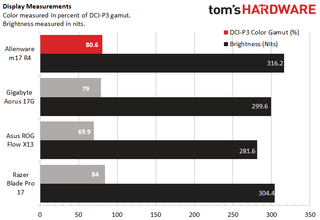
The Alienware m17 R4 comes with a choice of three different, 17-inch display panels: a 1080p panel with 144 Hz refresh rate, a 4K, 60 Hz panel and the 1080p, 360 Hz panel in our review unit. Our panel provided sharp images and accurate but mostly unexciting colors, along with smooth, tear-free gaming.
When I watched a trailer for upcoming volcano-disaster-flick Skyfire, the red-orange of lava bursts was lively and the green trees in a forest seemed true-to-life. Fine details like the wrinkles in actor Jason Isaacs’ forehead also stood out.
In a 4K nature video of a Costa Rican jungle, details like the scales on a snake and colors like the red on a parrot’s feathers were also strong, but not nearly as strong as when I viewed it on the 4K, OLED panel from the Alienware m15 R4 I tested recently. On both videos, viewing angles on the matte display were strong as colors didn’t fade even at 90 degrees to the left or right.
In Cyberpunk 2077, details like the threads on a rug or the barrel of a gun were prominent and colors like the red and yellow in the UI seemed accurate but didn’t pop.
The Alienware m17 R4’s display registered a strong 316.2 nits of brightness on our light meter, outpacing the Aorus 17G (299.6), the Razer Blade Pro 17 (304.4) and the Asus ROG Flow X13 (281.6). According to our colorimeter, the screen can reproduce a solid 80.6% of the DCI-P3 color gamut, which is about on par with the Aorus 17G and slightly behind the Razer Blade Pro 17, but miles ahead of the ROG Flow X13.
Keyboard and Touchpad on Alienware m17 R4
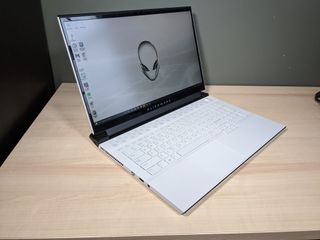
The Alienware m17 R4 comes with your choice of two different keyboards: an excellent standard mSeries keyboard with a snappy feel and a mechanical keyboard that may be the best of any laptop's. A $176 (as of this writing) upgrade option, the mechanical keyboard is the first to feature Cherry MX Ultra Low Profile switches.
Providing 1.8mm of travel in just a 3.5mm-high package, the Ultra Low Profile switches have the same kind of luxurious, clicky feel and and sound you'd expect from an external keyboard, without adding any heft to the laptop. They require a solid 65 grams of force to actuate, which is a little more than Cherry's MX Blue switches, which they sound and feel like.
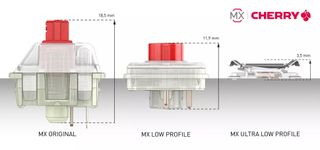
Alienware sent us a new review unit just to test the m17's mechanical keyboard and I came away impressed with the feel. Thanks to the robust feedback, I hit a strong 102 words per minute (slightly above my average) on the 10fastfingers.com typing test, with a 3 percent error rate and a great deal of comfort. I also found that gaming in Cyberpunk 2077 was a pleasure. For more details, see my article on going fingers on with the new Cherry MX Ultra Low Profile switches.
With a deep, 1.7mm of travel and some snappy feedback, the default Alienware mSeries keyboard also offers a great typing experience. On the tenfastfingers.com typing test, I scored the same 102 wpm / 3-percent error rate as with the mechanical keyboard. However, the clicky keys on the mechanical keyboard just felt a lot more responsive and pleasant to use.
Whichever keyboard option you choose, you get a full numeric keypad and four customizable macro keys above the pad on the top row. The Alienware Command Center software allows you to set these to launch a program, enter text or use a pre-recorded set of keystrokes when you hit them. I found programming them very unintuitive, however.it. Alienware Command Center also allows you to set RGB colors or lightning effects for four different zones on the default keyboard or on a per-key basis for the other keyboard options.
The 3.1 x 4.1 glass touchpad, which uses Windows precision drivers, offers great navigation with just the right amount of friction. Whether I was navigating around the desktop or using multitouch gestures such as pinch-zoom or three-finger swipe, the pad was always accurate and responsive.
Audio on Alienware m17 R4

The Alienware m17 R4’s audio system outputs sound that’s loud enough to fill a mid-sized room and rich enough to dance to. When I played AC/DC’s "Back in Black" with the volume all the way up, the sound was mostly accurate, but some of the high-pitched percussion sounds were a little harsh. Earth, Wind and Fire’s bass-heavy "September" sounded great, with a clear separation of sound where instruments such as the horns section appeared to come from a different side of the notebook than, for example, the drums.
Gunshots and the sound of my NPC friend Jackie yelling at me to stay down sounded sharp and clear in Cyberpunk 2077. However, I had to turn the volume way up to compensate for the fan noise when the system was on high performance settings. Even on the “quiet” thermal setting, fan noise was quite prominent.
The preloaded Alienware Command Center app has an audio section that lets you tweak the sound settings and choose among profiles such as Music, Movie, Shooter and Role Play. I found that the default “Alienware” profile sounded about the same as the Music one, but disabling the audio enhancement definitely made the sound flatter.
Upgradeability of the Alienware m17 R4
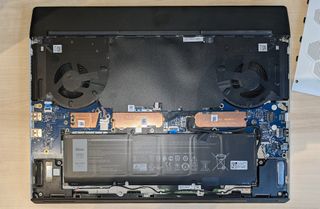
The Alienware m17 R4 has three different M.2 SSD slots, all of which are accessible and user upgradeable. The first slot is an short 2230 length and the other two are both the normal 2280 size. Unfortunately, the RAM is soldered onto the motherboard and therefore not replaceable.
Opening the Alienware m17 R4 should be easy: there are eight Philips-head screws, some of which come out and the others of which you can just loosen, on the bottom panel. In our testing, getting the screws loosened was easy by prying off the bottom panel was challenging and required several minutes with a spudger. Once the panel is off, all three SSDs are visible, but are covered by copper heat sinks you can easily unscrew.
Battery Life on Alienware m17 R4
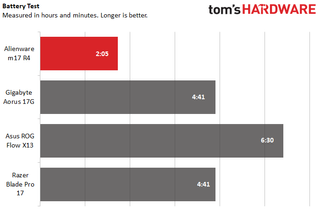
Forget about using the Alienware m17 R4 without a power outlet for any length of time. The laptop lasted just just 2 hours and 5 minutes on our battery test, which involves surfing the web over Wi-Fi at 150 nits of brightness. That’s awful in comparison to all of its competitors as both the Gigabyte Aorus 17G and Razer Blade Pro 17 lasted for an identical 4 hours and 41 minutes. But this is a 17-inch, 6.6-pound laptop so portability isn’t a primary concern.
Heat on Alienware m17 R4
The main touchpoints on the Alienware m17 R4 stay relatively cool when you’re not gaming and remain warm but tolerable when you are. After we streamed a YouTube video for 15 minutes, the keyboard hit a reasonable 35.5 degrees Celsius (95.9 degrees Fahrenehitt), the touchpad was a chilly 26.2 degrees Celsius (79.3 degrees Fahrenheit) and the underside was just 36.6 degrees Celsius (97.9 degrees Fahrenheit).
After running the Metro Exodus benchmark for 15 minutes to simulate gaming, those temperatures were obviously higher. The keyboard hit 35.5 degrees Celsius (112 degrees Fahrenheit), the touchpad measured 35 degrees (95 degrees Fahrenheit) and the bottom hit 50 degrees (122 degrees Fahrenheit).
When I played Cyberpunk 2077, the area around the WASD keys measured about 40 degrees Celsius (105 degrees Fahrenheit) but the key caps themselves didn’t feel uncomfortably warm to touch. At performance settings, the fan noise was extremely loud.
Webcam on Alienware m17 R4

The Alienware m17 R4’s 720p webcam is nothing special. Even when I shot it in a well-lit room, an image of my face was filled with visual noise and fine details like the hairs in my beard were blurry while colors such as the blue in my shirt and the green on the walls were muted. You’ll get by with this built-in camera if you need to, but you’d be better off springing for one of the best webcams.
Software and Warranty on Alienware m17 R4




The Alienware m17 R4 comes preloaded with a handful of useful first-party utilities.
Alienware Mobile Connect allows you to control your Android handset or iPhone from your laptop, taking calls and texts for the desktop.
Alienware Command Center lets you control all the RGB lighting effects, set keyboard macros, tweak audio settings and even modify the performance settings and thermals to go for better performance or quieter and cooler temps. You can even change the max frequency, voltage and voltage offset for the CPU manually if you have an unlocked CPU and want to try overclocking.
As with any Windows laptop, there’s also a small amount of preloaded bloatware, including a trial of Microsoft Office, links to download Photoshop Express and Hulu and free-to-play games like Roblox.
Alienware backs the m17 R4 with a standard one year warranty on parts and labor that includes in-home service (if there was already a remote diagnosis). You can pay extra to extend the warranty up to five years and you can add accidental damage protection with no deductible.
Configurations of Alienware m17 R4
When you purchase the Alienware m17 R4 from Dell.com, you can custom configure it with your choice of a Core i7 or Core i9 CPU, RTX 3070 or 3080 GPU, up to 32GB of RAM and up to 4TB of storage. You can choose white or blackcolor options and you can also pay extra to get per-key RGB lighting instead of the standard 4-zone lighting we tested.
You get three different keyboard options. The default mSeries keyboard feels snappy and has four-zone RGB lighting while a $29 upgrade gets you the same keyboard but with per-key lighting. Finally paying $176 extra (as of this writing), gets you the mechanical keyboard with Cherry MX Ultra Low Profile switches and per-key lighting. That's a hefty premium, but if you're already planning to spend more than $2,000 on a laptop, getting a best-in-class keyboard is a worthwhile upgrade.
You also get a choice of screens that includes 144 Hz and 360 Hz 1080p panels, along with a 4K, 60 Hz panel that promises to hit 100 % of the Adobe RGB color gamut. If you value image quality over fps, we recommend the latter, because the color on our 360 Hz panel was ok, but not exciting.
Our review configuration of the Alienware m17 R4 currently goes for $3,586.79. For that price, you get the Core i9-10980HK, RTX 3080 graphics, the 360 Hz display, 32GB of RAM and a combination of storage drives that includes two, 1TB M.2 PCIe SSDS in RAID 0 and a 512GB M.2 SSD by itself for a total of 2.5TB of storage. Dell lists the RAID drive as the boot drive in its store but our review model came with the 512GB drive as boot and the 2TB RAID drive as storage, which seems odd.
Bottom Line

At this point, it’s hard to imagine someone making a gaming laptop that’s significantly more powerful than the Alienware m17 R4 we tested unless they use desktop parts. The RTX 3080 is currently the fastest mobile GPU around, especially since Alienware didn't opt for Nvidia's more power efficient Max-Q technologies.. Using a strong cooling system, pairing it with a Core i9-10980HK, and you have performance that’s often 20% faster than competitors that also use RTX 3080s.
In addition to its strong performance, the Alienware m17 R4 offers a best-in-class mechanical keyboard or an almost-as-good standard keyboard, along with a uniquely attractive design that’s all its own. The 360 Hz screen is more than capable, but unless you’re a competitive gamer, you can go with the default screen or, better yet, go for the 4K panel which promises much richer colors.
The biggest drawbacks for this epic laptop are those which are kind of inherent to any 17-inch laptop which turns the performance volume up to 11. It’s heavy, has short battery life, emits plenty of fan noise. It's also quite expensive. It would be nice if, for this price, you got a better-than-awful webcam, but most laptop webcams are terrible.
If you want to save a few dollars or you need a little more battery life, consider the Gigabyte Aorus 17G, which goes for $2,699 with similar specs (but just 1TB of storage) to our Alienware m17 R4. The 17G lasts more than twice as long on a charge and weighs 0.65 pounds less than the m17, but its gaming performance isn’t as good.
If you don’t feel attached to the 17-inch form factor, consider the Alienware m15 R4, which has the same design and keyboard options but is much more portable, albeit hotter. It also has an optional, 4K OLED panel which has incredibly vibrant output. However, if you want the ultimate 17-inch gaming rig right now, the Alienware m17 R4 is your best choice.
-
Gurg It would be interesting to see how this would handle being paired with a 4k 60hz monitor. With hdmi 2.2 it should generate 60hz for 4k at close to 60fps. I spent approximately $2,400 (excluding monitor) on my desktop setup (9600k, 2080s, 16gb 3600 ram, couple of m.2 970s) and around $1,450 on my older 17" MSI laptop with a 970m. One of these high performance laptop could be an alternative to purchasing both separately.Reply
While you give up incremental upgrades. these laptop specs are approaching terminal specs for 4k 60hz setups. Terminal specs for 4k 144hz monitors are at least 2-4 years off even for desktops. -
saunupe1911 Dear Tom's Hardware,Reply
I really wish you guys would purchase a 4k 120hz TV. You guys got all of this gaming stuff...including consoles...but don't have a proper TV to test against. This doesn't make any sense.
There's an entire movement of 48 inch LG CX PC gamers. Numerous HDMI 2.1 monitors on the way as well. Get the company credit card and buy a dang TV smh -
Franesco1699 Sorry , how is fan noise when not gaming , i mean doing normal tasks like watching movies , word , mails, zoom/team calls and also if you used same programs lighter then gaming but not like word for example 2D Autocad or something like that , Thanks for the great rewiue and for the ansewer , really neded this rewiue to help me choose!Reply -
sreams I've had my ASUS ROG Strix G17 laptop for about a week now. Ryzen 5900HX, GeForce RTX 3070. $1800.Reply
Just installed Shadow of the Tomb Raider and ran the benchmark at 1920x1080 at highest settings. 99fps. So half the price and 96% of the performance of the Alienware, at least in this one benchmark. Can't say I'm at all disappointed. -
DivineJustice I used to rely very much on toms hardware for news and particularly reviews, but i'm starting to see they may not be reliable anymore. These "reviews" appear more like promotional adds than an actual in depth analysis of given products. They seem to want to hide things in order to oversell the product.Reply
Why are there no 1440 benchmarks whatsoever? A 3080 laptop, and specially one that can have a 4k screen such as this one, will for sure be used for at least 2k gaming, if not on its own screen then on a separate monitor. The fact you did not care to do a single 1440p benchmark tells me you are trying to obfuscate or hide the performance of the machine on higher resolutions. It is specially telling that you show the performance of several games on ultra settings in 1080p, but when you get to red dead redemption, you only benchmark the medium settings, because they're almost hitting the 60fps threshhold of acceptable gaming performance. What happened on ultra here?
Why is there little to no detail on RTX performance, with or without DLSS on, with games that support it? You mention cyberpunk, but you do not even mention what resolution was used (I suppose 1080p) or whether DLSS was enabled or not.
It really is dissapointing that this is how tech sites are deciding to approach laptop reviews these days, hiding the information consumers need to make good purchasing decisions.
Is it an issue of advertising money and integrity I wonder? -
tuppaacc Replysreams said:I've had my ASUS ROG Strix G17 laptop for about a week now. Ryzen 5900HX, GeForce RTX 3070. $1800.
Just installed Shadow of the Tomb Raider and ran the benchmark at 1920x1080 at highest settings. 99fps. So half the price and 96% of the performance of the Alienware, at least in this one benchmark. Can't say I'm at all disappointed.
Thank you for posting this, since I havent been able to find the ROG strix 17 ive beend desperately looking for an alternative, and was considering it, but nvm now, however it would be interesting to see how it performs when the m17 R4 is paired with a ryzen (considering thats whats giving asus an edge) not to mention it should lower temps significantly and give the gpu more headroom -
sreams Replytuppaacc said:Thank you for posting this, since I havent been able to find the ROG strix 17 ive beend desperately looking for an alternative, and was considering it, but nvm now, however it would be interesting to see how it performs when the m17 R4 is paired with a ryzen (considering thats whats giving asus an edge) not to mention it should lower temps significantly and give the gpu more headroom
Actually... I just switched out the stock 16GB of 3200MHz CAS22 memory for 32GB with the same speed/timings. For whatever reason, my Shadow of the Tomb Raider score jumped from 99fps to 117fps (immediate before/after benchmarks). I don't fully understand why this happened, but I'm not complaining. 3DMark CPU score also jumped by 1000pts. -
LVNeptune There is something wrong with the demo unit that TomsHardware received. My Alienware m17 R4 w/ 3070 at Highest gets 107fps on benchmark. The 3080 model should be SIGNIFICANTLY higher.Reply -
Charles Alden ReplyAdmin said:The Alienware m17 R4 with RTX 3080 graphics and Core i9-10980HK is a beast of a machine that can outperform direct competitors by as much as 20%.
Alienware m17 R4 Gaming Laptop Review: Can’t Get Much Faster : Read more
I recently bought mine after a mind boggling amount of research. I basically wanted a laptop that could run DCS flight simulator at the native resolution for the HTC Vive Cosmos Elite VR headset and do so with over 100FPS consistently. I also needed something small that would fit inside of my ViperWing F-18/F-35 flight sim cockpit that also sits upon on a custom built full motion platform.
I couldn't have asked for anything else as the Alienware R4 has worked flawlessly, I'm getting around 140+ FPS consistently with everything on high, including DCS's new cloud covering. Temperatures have been amazing, the battery lasts longer than I would have expected from such a powerful laptop, build quality is perhaps the best I've ever seen for a gaming PC, especially from someone who is sick and tired of seeing Aluminium being passed on as some sort of premium material when in fact it's actually one of the cheapest and less durable materials you can use in a laptop. Magnesium, new, hareder, polycarbonate and carbon fiber is where it's at. Though companies like Apple still use Aluminium, selling it off as premium when in fact you can bend any Apple product with little to no effort at all, you will be unable to bend this Alienware, nor will you be able to break it by standing on it or dropping it. In fact, it's durability is up there with the legendary Panasonic's Toughbooks. In which I actually own one of, the Toughpad FZ-G1 Mk5, that I use for traveling, camping and outdoor photography. It was a prize I had won from one of my firms Christmas Parties. They use them to debug servers in the field, so they must have had a few kicking around to give as prizes, still, a cool gift that I still thoroughly use and enjoy.
The Alienware replaced my Corsair One with a 2080TI that I bought almost three years ago, in fact, I actually almost bought the new one but it was over a grand more than the Alienware for what summed up to be just 40 more FPS. I know because I tested one belonging to a buddy of mine who talked me into getting the first Corsair One. Great little machines but you can build a better, faster machine for less, check out NZXT's BLD site for example.
That being said, I will most definitely be building a custom gaming PC running a RTX 3990 and a Ryzen 9 16 CORE, that is once the prices start to come down, hopefully there will even be a 3990 TI. Thank goodness I was able to buy my workstation/server with a Threadripper 3990X, a TRX40 AORUS XTREME motherboard and my prized dual AMD Radeon VII Pro's that I manged to buy well below MSRP before this whole shortage crisis started.
Thankfully things are slowly getting back to normal, even though I still think $1000 for a decent RTX 3080 is still way to expensive, even $700 for a RTX 3070, I mean Nvidia and AMD must be hurting at this point. -
phidarian I wound up buying this laptop:Reply
Intel(R) Core(TM) i7-10870H CPU
Win10 Home
RTX 3080 (16GB, full version, not Max Q which IIRC they don't offer)
32GB DDR4 2933Mhz
144Hz 7ms 300-nits 72% NTSC FHD monitor w/ nSync
4-zone lighting, b/c I don't need swag quite badly enough to do per-key
After a month, here's my honest feedback.
It's the Alienware flagship laptop. To go any faster, it would have to access the Speed Force or wear a cape with an S on it.
If it was any louder, I'd be able to hear it through my noise-cancelling gamer headphones. Seriously. Jet engine.
If it was any hotter, I'd be able to use it to cook. While playing Outriders (which is a great game and came with the laptop), it gets hot enough that I eventually can't hold my finger to parts of the laptop. In all fairness, those are parts of the laptop that there's no reason for me to touch... but still, it would've been nice if they spent the space they wasted for a port for their "graphic amplifier" product on another fan or something.
It's significantly lighter than anticipated, and aesthetically I'm a fan.
I had no trouble breaking 100wpm on the keyboard, and I didn't spring for the $200 keyboard upgrade.
The battery life is pretty bad, and I had to create my own power profile for energy saving because oddly enough it didn't come with one. To be fair, it's a 17"+ desktop replacement. I can just see Doc from Back to the Future making the energy profiles and going, "Low-power mode? Where we're going, we don't need low-power mode." Still, with a couple of tricks (and obviously not while gaming) I pulled almost 3 hours which isn't the end of the world for a desktop replacement.
Conclusions:
While Outrider isn't the most demanding game on the market, it's the most demanding game I've played so far because I basically can't put it down. I did play League; at one point, I broke 600fps and I never came close to dropping below the 144 gSync's refresh rate. On TFT, I actually broke 800fps at one point but TFT isn't exactly challenging. It doesn't lag on Outriders (other than the first 0.5-1.5 seconds of the intro video while it revs up). Literally 0 lag; I'm most of the way through the game and settings are maxed. Whether that means I'm getting 144fps or 344fps I have no idea. Supposedly the Command Center software will allow you to o/c but it's so fast and hot that I haven't bothered playing with it yet. I would need a laptop pad or something to cool it down to even bother.
Side note: Alienware has a built-in feedback mechanism that automatically opens when you start the control center. If you try and leave it mediocre feedback, it "crashes" - hmm.
Cheers.

